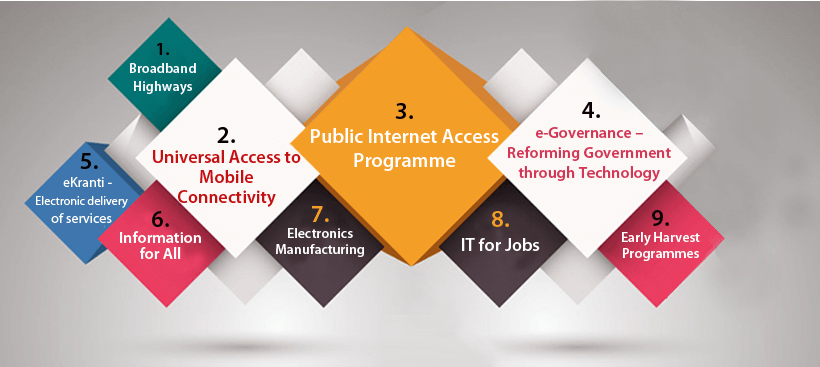Trendy campaigns are a thing in this country and it’s more than just being viral on digital platforms. Every Indian would definitely know or has heard of these trendy, catchy campaigns from the Indian Government. But what really makes them so trendy? The communication is crystal clear to the locals. Having a simple, inspiring message with a catchy name to the campaign is what makes it viral and easy to remember. Here are few of the many political campaigns that have become extremely popular amongst Indians with some still being actively followed.
Digital India – Power to Empower
With internet users growing rapidly now in India, the Modi government launched the Digital India Programme in 2015 and is still actively initiating new sub-programmes under this theme to encourage the youth of India. Low-cost internet services and packages have made it way easier and cheaper for nearly 500 million users to access the internet. They pushed this digital initiative by launching apps and websites that serve citizens.

Image credits: https://digitalindia.gov.in/content/programme-pillars
This campaign was a hit because of its communication being “Power to Empower” where they initiated these sub-campaigns that help the youth grow digitally. They used technology to their advantage to create easy access to budding entrepreneurs, students, jobseekers, learners, or every Indian in general.
Why was this campaign trendy?
- Catchy slogan
- The Hashtag #DigtialIndia was widely used on social media
- Pushed people to go digital and be more tech-savvy
- Literacy campaign for “information”
- The convenience of the app and websites for all kinds of tasks like bookings, payments, aadhar related requirements (People recommended apps to each other and indirectly empowering each other).
- Beneficiary to other government schemes including Make in India, Bharatmala, Sagarmala, Startup India, BharatNet, and Standup India
Swachh Bharat – Clean India Mission
We all know where our country stands when it comes to cleanliness and waste management! It was important to address this crisis with rational yet actionable solutions. Hence, the Clean India Mission or Swachh Bharat Abhiyan was launched on Gandhi Jayanti 2014 with a primary vision of promoting a cleaner country to live in. Promoting values of cleanliness and hygiene maintenance in cities as well as rural areas where it is much needed. Swachh Bharat made every individual responsible for the cleanliness and sanitation of their neighbourhood. This campaign was accepted by all almost immediately and with full enthusiasm. It’s still active today. Even celebrities took part in this initiative of keeping the surroundings clean, setting an example for their youth fans.
Why was this campaign trendy?
- A simple yet powerful message
- Images of cleaning neighbourhoods became viral because of celebrities
- Educated people about hygiene and waste management
- Became the world’s largest toilet-building initiative
- More than 95 million toilets were built for rural residents
- #Trashtag challenge became viral amongst youth-promoting cleanliness in their respective neighbourhoods
- Live videos shared across social media platforms of cleanliness drills in colleges, universities, offices, public places across the country
Make in India
Another type of “Swadeshi Movement”, Make in India was launched by Prime Minister Modi in Sept 2014 with the objectives of job creation that will cover 25 sectors of the Indian economy. It was devised to transform our country into a global manufacturing hub and encourage other brands to manufacture their products in India. The initiative also encouraged Indian brands to have a high-end production mechanism that would manufacture products with no defects and no adverse environmental harm.
Why was this campaign trendy?
- Promoting India as a global design/manufacturing hub
- An inspiring campaign for Indian brands to increase better productions
- “Zero Defect, Zero Effect” slogan was catchy for people to remember the communication theme of Make in India
- Gave global brands an opportunity to set up manufacturing hubs in the country
- Boosted the economy with more foreign brands investing in Indian hubs

Image credit: https://en.wikipedia.org/wiki/Make_in_India
Vocal For Local
To give you a little shocker, ‘Vocal for Local’ isn’t a new concept to us Indians. It’s a movement dating back to the year 1905, an era of the Swadeshi Movement to achieve independence at the time. Its communication message is the simplest: BUY LOCAL. This campaign is an extension of Make in India but just focuses on Indian brands to bloom. The campaign was launched in 2014 by PM Modi. However, ‘Vocal for Local’ has suddenly become popular again due to the Covid-19 pandemic. This encouraged individuals to buy groceries or other essentials locally rather than choosing supermarts. This campaign gave small startups a thriving chance of receiving local leads/ customers/ clients. Even big brands like Dabur Red Paste have created marketing ads with the “Vocal for Local” message as their theme.
https://www.youtube.com/watch?v=a0lwhpTxAQQ
Why was this campaign trendy?
- Catchy slogan name
- Became a popular hashtag for Indian brands and consumers to use on social media
- Big Indian brands used this as an opportunity to market their products. This boosted the campaign even more.
- The campaign was viral everywhere through mediums like print ads, youtube ads, television advertisements, billboards, social media ads/posts
Aatmanirbhar Bharat
Prime Minister Modi launched the Aatmanirbhar Bharat campaign recently. This has been primarily launched to aid economic and other crises due to the Covid-19 pandemic. This campaign involves a package that helps companies that are hit by the pandemic/ lockdown. Basically, encouraging them to be “self-reliant” to thrive in the highs and lows of the market. There are 5 pillars that benefit through this financial aid campaign: Economy, Infrastructure, System, Demography, Demand.
Why is this campaign trending now?
- The slogan is catchy and the hashtag is widely being used by nearly every entrepreneur/ business owner trying to be self-reliant in this economic crisis.
- “Share your aatmanirbhar story” initiative has encouraged many others to register and share their story with the world on the official website: https://aatmanirbharbharat.mygov.in/
- This campaign has inspired professionals to create desi alternatives for apps such as CamScanner that was banned in India.


